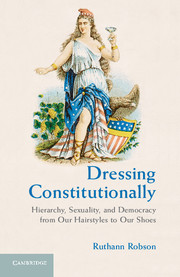1 - Dressing Historically
Published online by Cambridge University Press: 05 July 2013
Summary
The first laws regulating dress in the English realm appeared well after the creation of the foundational documents of democracy. The most famous instrument, the Magna Carta of 1215, still resonates as a quasi-constitution that allocates power and recognizes individual liberties. It also contained a specific provision regulating textiles: “There shall also be a standard width of dyed cloth, russett, and haberject, namely two ells within the selvedges.” It did not, however, impede the creation of laws regulating dress.
The sole law passed by the English Parliament in the year 1337 was devoted to matters of wool, cloth, and fur. Although there were certainly ancient Greek, Roman, and Asian laws as well as medieval European and Asian laws governing attire, this law promulgated by Parliament in the eleventh year of the reign of Edward III is the first recorded statute addressing attire in the English realm. The statute forbade the exportation of wool and the importation of foreign cloth; it also governed the “Cloth-workers of strange Lands,” who would be welcome in the realm and granted franchises. Taken together, these provisions evince a government concerned with the economy: the statute banned exports and imports but encouraged foreign entrepreneurs to relocate within the realm. The remaining two sections of the statute, however, expressed slightly different concerns. They banned the wearing of imported cloth and the wearing of fur and they included exemptions to these bans.
- Type
- Chapter
- Information
- Dressing ConstitutionallyHierarchy, Sexuality, and Democracy from our Hairstyles to our Shoes, pp. 8 - 33Publisher: Cambridge University PressPrint publication year: 2013



